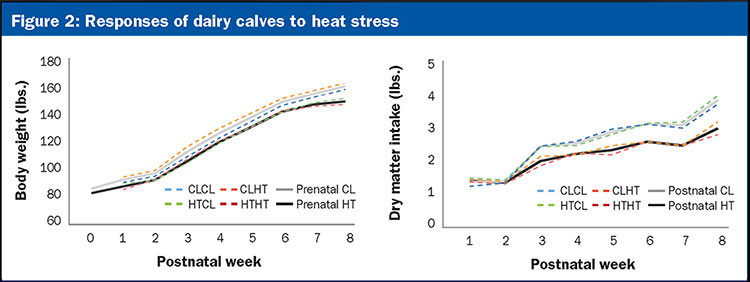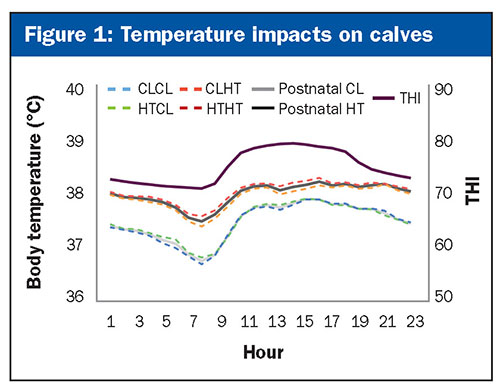Heat stress abatement is not a novel concept to those in dairy circles. Decades of research indicate that heat-stressed lactating dairy cows will reduce feed intake and drop milk production. Also, cows exposed to heat stress across the dry period will experience a 10- to 16-pound per cow per day decline in production across their entire next lactation, even if they are cooled during lactation.
Meanwhile, research of heat stress abatement on dairy calves is limited. Young stock are generally not considered in heat stress abatement conversations due to their higher heat thresholds and lack of immediate milk production responses. However, dairy calf hyperthermia still leads to negative consequences on welfare and productivity.
While we are gathering a better understanding of dairy calf heat stress, we must remember heat stress is often not a short-term event, and thus could impact young stock across multiple stages of development.
For instance, the dry period coincides with late gestation, when the dairy calf in utero is growing at the quickest rates. Consequently, the developing calf is exposed to heat stress throughout the intrauterine environment. We now know that prenatally heat-stressed calves weigh less at birth and at weaning, are less likely to survive to lactation, and if they enter the lactating cow herd, will produce on average 10 pounds per cow per day less milk across their entire first lactation.
Similarly, dairy calves directly exposed to high heat loads after birth will experience higher rectal temperatures, skin temperatures, and respiration rates. They will also exhibit reduced average daily gains and lowered feed intakes as well as impaired immune responses, which lead to higher mortality rates. In fact, postnatal exposure to heat stress can have long-term consequences in productivity. This is particularly relevant in states across the southern and southeastern U.S. that can experience over 100 heat stress days a year.

Before, after, or both?
Our group at the University of Florida sought to determine the combined effect of both pre- and postnatal heat stress abatement on dairy calf activity, metabolism, and growth. Our main objective was to successfully provide heat stress abatement to dairy calves in both their prenatal (in utero) and postnatal (after birth) environments.
Briefly, calves experienced prenatal cooling (CL) including fans, soakers, and shade or heat stress (HT). In HT, shade was provided to their dam for about 46 days before birth. After birth, all calves were assigned to group automatic feeder pens with either access to shade and fans with average wind speed around 4.5 miles per hour (2 meters per second) (postnatal CL) or only the shade of the barn (postnatal HT) resulting in four treatment groups:
- Cooled prenatally and cooled postnatally (CLCL)
- Cooled prenatally but heat stressed postnatally (CLHT)
- Heat stressed prenatally but cooled postnatally (HTCL)
- Heat stressed prenatally and postnatally (HTHT)
The four treatment groups were allowed 2.64 gallons (10 liters) per day of milk replacer, 6.6 pounds (3 kilograms) per day of grain, and ad libitum water, with weaning starting at 42 days and ending at 56 days of age. Environmental temperature and humidity and body temperature were also measured hourly to determine success of treatments and evaluate daily fluctuations. We assessed daily vital responses, daily feed intakes, and weekly body weights from birth to weaning.
For the duration of our trial (July to October 2018), THI remained above 68 even during the night. Across the entire day, calves provided postnatal cooling maintained a body temperature that was 0.5°C to 1°C lower than calves exposed to postnatal heat stress. When THI dropped to its lowest levels of the day (around 2 to 5 a.m.), it took all calf groups additional time to respectively drop body temperatures to their lowest levels (around 7 a.m.), but postnatally cooled calves were able to lower body temperatures further. Notably, all groups had body temperatures within the physiological range.
As expected, all vital responses were lowered by postnatal cooling. At the hottest time of the day, HTHT calves had higher respiration rates and rectal temperatures compared to the other treatment groups. This means that prenatal heat stress may predispose calves to respond more poorly when exposed to continued stress after birth.
Interestingly, HTCL calves had some of the lowest respiration rates throughout the day while CLHT calves had, by far, the lowest heart rates, which also points toward prenatal programming that responds to an opposing postnatal environment. These results indicate that both prenatal and postnatal heat stress hinders dairy calf welfare.
Lifetime benefits
A strong indication of effective heat stress abatement is production responses, such as body weight gain, feed intake, and overall feed efficiency. Surprisingly, only prenatal cooling impacted calf body weight, with prenatally cooled calves weighing 4 pounds more at birth and 15 pounds more at weaning compared to prenatally heat-stressed calves (Figure 1). Thus, average daily gain tended to be higher for prenatally cooled calves by about 0.15 pounds per day.

In contrast, feed intake was driven by postnatal environment. Calves cooled postnatally consumed both more milk and grain across the preweaning period, leading to improvements of 0.5 to 1 pound per day in overall dry matter intake, particularly during and after weaning. Because of this disparity between influences on body weight and feed intake, the CLHT treatment group was the most feed efficient, especially around weaning. From this data, we confirm that providing heat stress abatement to dry pregnant dams improves productive measures of the offspring; however, it is important to note that postnatal cooling is central in promoting feed intake.
Interestingly, calves provided postnatal cooling had a reduced number of treatments for infection (horn bud, ear tag, or navel) and fever and averaged two treatments through 56 days, while postnatal heat-stressed calves were treated three times on average. If calves refused to suckle from the automatic feeder or by bottle, they were fed by esophageal tube. Calves exposed to prenatal heat stress required more tube feeding compared to prenatal cooled calves. Therefore, by providing pre- and postnatal cooling, there is a potential to reduce labor and treatment costs.
Overall, our results demonstrate the importance of dairy calf heat stress abatement both before and after birth. Heat stress in these critical developmental periods impairs welfare and thermoregulation and inhibits growth and feed intake in the preweaning period.
We plan to follow these animals across breeding age and through their first lactation to capture reproductive and milk production responses, as heat stress abatement has been shown to impact these main economic priorities. Armed with this information and future research, we hope to develop practical strategies that may alleviate or rescue the negative consequences of dairy calf heat stress.










